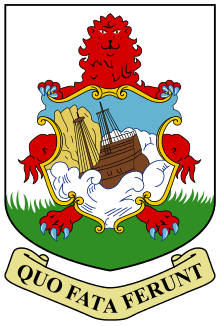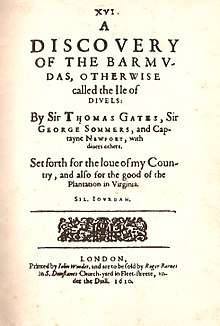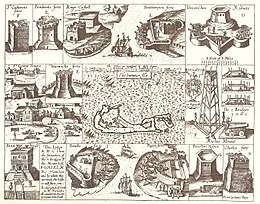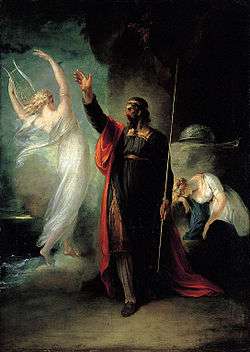Sea Venture
 The coat of arms of Bermuda features a representation of the Sea Venture wreck. | |
| History | |
|---|---|
| Cost: | £1,500 |
| Launched: | 1609 |
| General characteristics | |
| Tonnage: | 300 tonnes |
| Armament: |
|
Sea Venture was a seventeenth-century English sailing ship, part of the Third Supply mission to the Jamestown Colony, that was wrecked in Bermuda in 1609. She was the 300 ton purpose-built flagship of the London Company and a highly unusual vessel for her day, given that she was the first single timbered, merchantman built in England, and also the first dedicated emigration ship. Sea Venture's wreck is widely thought to have been the inspiration for Shakespeare's play The Tempest.
The Virginia Company
The proprietary of the London Company had established the settlement of Jamestown in Virginia in 1607, and delivered supplies and additional settlers in 1608, raising the English colony's population to 200, despite many deaths. The entire operation was characterized by a lack of resources and experience. The Company's fleet was composed of vessels that were less than optimal for delivering large numbers of passengers across the Atlantic Ocean, and the colony itself was threatened by starvation, diseases, and warfare with native peoples.
The colony at Jamestown seemed doomed to meet the same fate as the Roanoke Colony and the Popham Colony, two earlier failed English attempts to settle in North America, unless there was a major relief effort, despite the delivery of supplies in 1608 on the First and Second Supply missions of Captain Christopher Newport. Yet the investors of the London Company expected to reap rewards from their speculative investments. With the Second Supply, they expressed their frustrations and made demands upon the leaders of Jamestown in written form. They specifically demanded that the colonists send commodities sufficient to pay the cost of the voyage, a lump of gold, assurance that they had found the South Sea, and one member of the lost Roanoke Colony.
It fell to the third president of the Council to deliver a reply. Ever bold, Captain John Smith delivered what must have been a wake-up call to the investors in London. In what has been termed "Smith's Rude Answer", he composed a letter, writing (in part):
When you send againe I entreat you rather send but thirty Carpenters, husbandmen, gardiners, fishermen, blacksmiths, masons and diggers up of trees, roots, well provided; than a thousand of such as wee have: for except wee be able both to lodge them and feed them, the most will consume with want of necessaries before they can be made good for anything.[1]
Smith did begin his letter with something of an apology, saying "I humbly intreat your Pardons if I offend you with my rude Answer".[2]
There are strong indications that those in London comprehended and embraced Smith's message. Their Third Supply mission was by far the largest and best equipped. They even had the newly constructed purpose-built flagship Sea Venture placed in the most experienced hands of Christopher Newport.
Construction
The Company built Sea Venture, probably in Aldeburgh, as England's first purpose-designed emigrant ship and in response to the inadequacy of its vessels. She measured "300 tunnes", cost £1,500, and differed from her contemporaries primarily in her internal arrangements. Her guns were placed on her main deck, rather than below decks as was then the norm. This meant that the ship did not need double-timbering, and she may have been the first single-timbered, armed merchant ship built in England. The hold was sheathed and furnished for passengers. She was armed with eight 9-pounder (4.1 kg) demi-culverins, eight 5-pounder (2.3 kg) sakers, four 3-pounder (1.4 kg) falcons, and four arquebuses. The ship was launched in 1609, and her uncompleted journey to Jamestown appears to have been her maiden voyage.
Loss
On 2 June 1609, Sea Venture set sail from Plymouth as the flagship of a seven-ship fleet (towing two additional pinnaces) destined for Jamestown, Virginia as part of the Third Supply, carrying 500 to 600 people (it is unclear whether that number includes crew, or only settlers). On 24 July, the fleet ran into a strong storm, likely a hurricane, and the ships were separated. A pinnace, Catch, went down with all aboard lost.[3] Sea Venture however, fought the storm for three days. Comparably sized ships had survived such weather, but Sea Venture had a critical flaw in her newness: her timbers had not set. The caulking was forced from between them, and the ship began to leak rapidly. All hands were applied to bailing, but water continued to rise in the hold.
The ship's starboard-side guns were reportedly jettisoned to raise her buoyancy, but this only delayed the inevitable. The Admiral of the Company himself, Sir George Somers, was at the helm through the storm. When he spied land on the morning of 25 July, the water in the hold had risen to 9 feet (2.7 m), and crew and passengers had been driven past the point of exhaustion. Somers deliberately had the ship driven onto the reefs of Discovery Bay, in what later proved to be eastern Bermuda, in order to prevent its foundering. This allowed all 150 people aboard, and one dog, to be landed safely ashore.[4] The survivors, including several company officials (Lieutenant-General Sir Thomas Gates, the ship's captain Christopher Newport, Sylvester Jordain, Stephen Hopkins, later of Mayflower, and secretary William Strachey), were stranded on Bermuda for approximately nine months.
Deliverance and Patience

During the time on Bermuda, the survivors constructed two new ships, the pinnaces Deliverance and Patience, from local Bermuda cedar, which was a wood especially prized by regional ship builders because it was as strong as oak, yet lighter. This misnamed juniper species could be worked with immediately after felling, and it has high resistance to rot and wood worms. Materials salvaged from the beached wreck were also used, especially her rigging.[5] They were constructed between late fall 1609 and early spring 1610 under the guidance of Admiral Somers and James Davis, Captain of the "Gift of God" who possessed considerable ship building knowledge. These ships represented the second and third pinnaces built in the English colonies in the Americas, the first being the 1607–08 construction of Virginia at the Popham Colony in New England.
The original plan was to build only one vessel, Deliverance, but it soon became evident that she would not be large enough to carry the settlers and all of the food that was being sourced on the islands. While the new ships were being built, Sea Venture's longboat was fitted with a mast and sent under the command of Henry Ravens to find Virginia, but the boat and its crew were never seen again.[6] Finally, under the command of Newport, the two ships with 142 survivors set sail for Virginia on 11 May 1610, and arrived at the Jamestown settlement on the 23rd, a journey of less than two weeks.[7] Two men, Carter and Waters, were left behind; they had been convicted of unknown offences, and fled into the woods of Bermuda to escape punishment and execution.[8]
On reaching Jamestown, only 60 survivors were found of the 500 or so who had preceded them. Many of these were themselves dying, and Jamestown was quickly judged to be nonviable. Everyone then boarded Virginia, Deliverance, and Patience, which set sail for England. The timely arrival of another relief fleet, bearing Governor Baron De La Warre, granted Jamestown a reprieve. All the settlers were relanded at the colony, but there was still a critical shortage of food. In the fall of 1610, Admiral Somers returned to Bermuda in Patience to obtain wild pigs and food that had been stockpiled there. Unfortunately, Somers died in Bermuda from a "surfeit of pork" and the pinnace, captained by his nephew Mathew Somers, returned directly to Lyme Regis in Dorset, England with the body in order to claim his inheritance.[9]
Wreck

Sea Venture sat atop the reefs off Gate's Bay long enough to be stripped of all useful parts and materials, not only by her crew and passengers, but by subsequent settlers; what was left of her eventually disappeared beneath the waves. Two of her guns were salvaged in 1612 and used in the initial fortification of Bermuda (one was placed on Governor's Island, opposite Paget's Fort, the other on Castle Island).[10] After the wreck's submergence, her precise location was unknown until rediscovered by sport divers Downing and Heird in October 1958, still wedged into a coral reef. There was little left of the ship or its cargo. Despite the lack of artifacts to be found, she was positively identified in 1959, in time for the 350th anniversary of the wrecking. Subsequent research uncovered one gun and cannonball, along with shot for small arms. There were also some Spanish jars, stoneware from Germany and ceramics and cooking pots much like what had been found excavating Jamestown.[11]
In fiction
- The wrecking is believed to have inspired William Shakespeare's The Tempest. This tradition has been confirmed by a detailed comparison to survivors' narratives such as Sylvester Jordain,[12][13] and that of historian and author William Strachey, who wrote an account of the storm entitled True Reportory of the Wrack, and Redemption of Sir Thomas Gates Knight, was the primary source Shakespeare drew upon.[14]
- Bermuda resident and novelist, F. Van Wyck Mason, wrote a fictionalised account of the wrecking, The Sea 'Venture, first published in 1961.
- 20th-century American author Scott O'Dell wrote and published a fictionalized account of Sea Venture shipwreck called The Serpent Never Sleeps.
- Children's author Clyde Robert Bulla wrote a fictionalized account of Sea Venture voyage called A Lion to Guard Us. It focuses on three children sailing to Jamestown to find their father.
- Sea Venture was also the namesake of a cruise liner which operated between the US and Bermuda in the 1970s for Flagship Cruises, before being obtained by Princess Cruises, which renamed her Pacific Princess, which was subsequently used in the television show The Love Boat.[15]
See also
References
- ↑ Smith 1624, p. 150.
- ↑ Smith 1624, p. 147.
- ↑ [needs reference: said to have been "a ketch" in tow by the 'Sea Venture' and intentionally cast adrift in the hurricane; why do we suppose anyone at all was still on board?]
- ↑ Horn, James (2006). A Land as God Made It: Jamestown and the Birth of America. New York: Basic Books. pp. 158–160. ISBN 0-465-03094-7.
- ↑ Forests filled with 'cedar' were everywhere on Bermuda, and the colony became a major ship building center after the dissolution of the Somers Isles Company in 1684. Export of Bermuda cedar for ship building had been severely restricted by the local assembly in 1627, but shipbuilding had denuded much of Bermuda's landscape by the 1830s.
- ↑ Evans 1957, p. 7.
- ↑ Christopher Newport had an extraordinary career as privateer and then ship captain for the Virginia Company of London. He captained the flagship Susan Constant that planted the first settlers in Virginia, landing on April 26, 1607. He then commanded John and Francis, and Phoenix, two ships that comprised the First Supply, and delivered 120 additional colonists to Jamestown on January 8, 1608. As captain of the 150 ton Mary Margaret, Newport also led the Second Supply to Jamestown. The Second Supply landed in September 1608 and delivered 70 colonists that included the first women from England. Adventure never stopped with Christopher Newport. On a voyage to Indonesia for the British East India Company, he died in Java in 1617.
- ↑ Smith 1624, p. 344.
- ↑ Overall, the food and supplies brought by the Third Supply were not adequate. 80% of the colonists would die during the Starving Time of 1610. Afterwards, survivors at Jamestown had boarded Deliverance and Patience and were sailing downstream to the ocean when they met yet another resupply fleet. Lord Delaware was this expedition's leader and he turned the distraught settlers back. He had brought a doctor but food supplies remained inadequate.
- ↑ Harris, Edward Cecil (1997). Bermuda Forts 1612–1957. Bermuda Maritime Museum Press. ISBN 0-921560-11-7.
- ↑ Making landfall at Jamestown (2005) Accessed 2017-01-22
- ↑ Vaughan & Vaughan 1991, p. 41.
- ↑ Evans 1957, p. 5.
- ↑ Vaughan & Vaughan 1991, pp. 38–40.
- ↑ McKenna, Robert (2003). The Dictionary of Nautical Literacy. McGraw-Hill Professional. p. 276. ISBN 0-07-141950-0.
- Bibliography
- Evans, Cerinda W. (1957). Some Notes on Shipbuilding and Shipping in Colonial Virginia. Williamsburg, Virginia: 350th Anniversary Celebration Corp.
- Smith, John (1624) [1624]. The Generall Historie of Virginia, New England & the Summer Isles, Together with The True Travels, Adventures and Observations, and A Sea Grammar. J. MacLehose.
- Vaughan, Alden T.; Vaughan, Virginia Mason (1991). Shakespeare's Caliban: A Cultural History. Cambridge University Press. ISBN 0-521-45817-X.
Further reading
- Doherty, Kieran (2008). Sea Venture: Shipwreck, Survival, and the Salvation of the First English Colony in the New World. St. Martin's Press. ISBN 9780312382070.
- Jourdain, Sylvester (1610). A Discovery of the Bermudas. London: John Windet.
- Lefroy, John Henry (1879). Memorials of the Discovery and Early Settlement of The Bermudas or Somers Isles, 1515–1685. I. London: Longmans, Green, and Company.
- Masden, RG (December 1905). "Ships in the Reign of James 1st". Transactions of the Royal Historical Society (New Series). Royal Historical Society. 19: 309–342. doi:10.2307/3678236. (Subscription required (help)).
- Nichols, A. Bryant, Jr (2007). Captain Christopher Newport: Admiral of Virginia. Sea Venture LLC. ISBN 9780615140018.
- Price, David A. (2003). "Chapter 10: Restoration". Love and Hate in Jamestown: John Smith, Pocahontas, and the Start of A New Nation. Alfred A. Knopf.
- Strachey, William (1625). "True Reportory of the Wrack, and Redemption of Sir Thomas Gates Knight". In Purchas, Samuel. Haklvytvs posthumus, or, Pvrchas his Pilgrimes (msdoc)
|format=requires|url=(help). 4. London: William Stansby. p. 1734ff. - Woodward, Hobson (2009). A Brave Vessel: The True Tale of the Castaways Who Rescued Jamestown and Inspired Shakespeare's The Tempest. Viking. ISBN 9781101060322.
- Wright, P.M. The Sea Venture Story. Bermuda Press.
External links
- "The Sea Venture". rootsweb. – Ship Passenger and Immigration Lists
- "ANTH318 Nautical Archaeology of the Americas Class 14". Nautical Archaeology at Texas A&M University.
- "Admiral Sir George Somers colonized Bermuda". Bermuda Online.
- Mountford, Kent (1 May 2000). "Lessons from Jamestown 1609–1610: starving in the land of plenty". Chesapeake Bay Journal. Archived from the original on 17 March 2006.
- "The Sea Ventture". Packrat Pro. – Packrat Pilgrim Ship Lists - the Sea Venture
